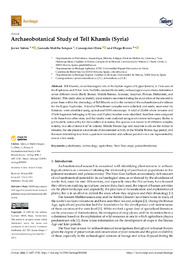Título :
Archaeobotanical Study of Tell Khamîs (Syria) |
Autor :
Valera, Javier
Matilla Seiquer, Gonzalo
Obón, Concepción
Rivera, Diego |
Editor :
MDPI |
Departamento:
Departamentos de la UMH::Biología Aplicada |
Fecha de publicación:
2022-07 |
URI :
https://hdl.handle.net/11000/38323 |
Resumen :
Tell Khamîs, an archaeological site of the Syrian region of Upper Jazeera, is 3 km east of
the Euphrates and 31 km from Yarâblûs (ancient Karkemiš); archaeological excavations determined
seven different levels (Early Bronze, Middle Bronze, Aramaic, Assyrian, Persian, Hellenistic, and
Islamic). This study aims to identify plant remains recovered during the excavation of the site and to
place them within the chronology of Tell Khamîs and in the context of the archaeobotanical evidence
for the Upper Euphrates. A total of 88 sediment samples were collected, and seeds, recovered via
flotation, were identified using optical and SEM microscopy. A total of 20,606 whole remains and
37,646 fragments belonging to 92 taxa and 35 plant families were identified. Seed lists were compared
with those from other sites, and the results were analyzed using multivariate techniques. Barley is
particularly noteworthy for the number of remains; this species was found in 49 different samples,
notably, in a silo of about 4 m3 in volume. Middle Bronze Age and Assyrian levels are the richest in
remains; the site presents a maximum of documented activity in the Middle Bronze Age period, and
the most interesting taxa from a paleoenvironmental and cultural point of view are represented by
one or a few seeds.
|
Palabras clave/Materias:
paleobotany
archaeology
agriculture
Near East
crops
paleoethnobotany |
Tipo de documento :
info:eu-repo/semantics/article |
Derechos de acceso:
info:eu-repo/semantics/openAccess |
DOI :
https://doi.org/10.3390/heritage5030088 |
Publicado en:
Heritage 2022, 5, 1687–1718 |
Aparece en las colecciones:
Artículos - Biología Aplicada
|
 La licencia se describe como: Atribución-NonComercial-NoDerivada 4.0 Internacional.
La licencia se describe como: Atribución-NonComercial-NoDerivada 4.0 Internacional.
.png)
